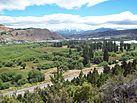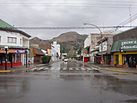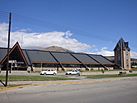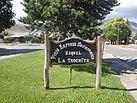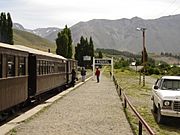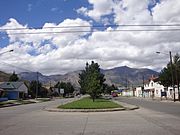Esquel, Argentina facts for kids
Quick facts for kids
Esquel
|
|
|---|---|
|
|
|
| Country | |
| Province | |
| Department | Futaleufú |
| Founded | February 25, 1906 |
| Elevation | 563 m (1,847 ft) |
| Population
(2010 census)
|
|
| • Total | 32,343 |
| Time zone | UTC−3 (ART) |
| CPA base |
U9200
|
| Dialing code | +54 2945 |
| Climate | Csb |
| Website | esquel.gov.ar |
Esquel is a lively city in the beautiful Patagonia region of Argentina. It's located in the northwest part of Chubut Province. Esquel is famous for being the home of "La Trochita," a historic narrow-gauge train also known as "The Old Patagonian Express."
The city is also known for its amazing ski area called "La Hoya." It's a great starting point for visiting Los Alerces National Park. This park is a special UNESCO protected area with some of the oldest trees in South America. The name Esquel comes from a Tehuelche word. It might mean "marsh" or "land of burrs," which refers to the many thorny plants found there.
Contents
History of Esquel City
The story of Esquel began with Welsh immigrants who arrived in Chubut in 1865. The town itself was officially created on February 25, 1906. It was an expansion of an earlier settlement called Colonia 16 de Octubre, which also includes the town of Trevelin.
The city sits by the Esquel Stream. It is surrounded by mountains like La Zeta, La Cruz, Cerro 21, and La Hoya. La Hoya is a popular ski resort. It has excellent snow that lasts well into spring. Los Alerces National Park is about 50 kilometers (31 miles) northwest of the city.
The Old Patagonian Express: La Trochita
A very important tourist attraction in Esquel is the narrow-gauge railway. It has tracks that are only 750 millimeters (30 inches) apart. This train is locally known as La Trochita. In English, it's called The Old Patagonian Express, thanks to a book by Paul Theroux.
This railway is 402 kilometers (250 miles) long. It is said to be the only long-distance narrow-gauge line still running. It is also the southernmost railway in the world. The first 50 steam locomotives were made in Germany in 1922. Later, 25 more were bought from the United States.
The train is still real and working today. This is thanks to the hard work of the team at Talleres Ferroviarios El Maiten. They even make many parts by hand. Today, the train runs as a fun tourist trip between Esquel and a small place called Nahuel Pan. You can also take it all the way to El Maitén. Before 1993, the train used to go much further. It connected to other train lines that could take you to Buenos Aires.
-
The Old Patagonian Express at Esquel station
Growth and Community Decisions
In 2001, the Esquel area had about 28,000 people. The city has been growing quickly. Many people from Buenos Aires and other parts of Argentina have moved there. Esquel has wide, clean streets and good sidewalks. The local hospital is very important for the area. People even travel there for medical care.
In 2003, the people of Esquel made a big decision. They held a special vote about a mining project. Most voters, 81% of them, said no to the project. They wanted to protect their environment. In May 2009, Esquel became "twinned" with the town of Aberystwyth in Wales. This means they are like sister cities, sharing culture and friendship.
Esquel Meteorite Discovery
In 1951, something amazing was found near Esquel. A farmer was digging a hole for a water tank. He discovered a huge meteorite weighing 755 kilograms (1,664 pounds)! This meteorite was later named Esquel.
When parts of the Esquel meteorite are cut and polished, they show beautiful yellowish crystals. These crystals are called olivine, or peridot. The Esquel meteorite is famous around the world. Scientists and collectors are very interested in it.
Esquel's Climate and Weather
Esquel has a cool summer Mediterranean climate. This means it has mild summers and cool, wet winters. It's located on the side of the Andes mountains. This location affects its weather.
Seasonal Weather Patterns
Summers in Esquel are mild. Afternoons are warm, but nights are cool. The average temperature in summer is around 14°C (57°F). Summer is also the sunniest time of year. You can expect about 10 hours of sunshine each day in January.
Spring and fall are transition seasons. Days are mild, and nights can be cool or cold. The weather can change a lot during these seasons. Winters are cool to cold, with temperatures often near freezing. It rains and snows a lot in winter. Snow falls on about 20 days each winter. However, it usually doesn't pile up very deep.
Rainfall and Sunshine
Esquel gets about 504 millimeters (20 inches) of rain each year. Most of this rain falls during the winter months. The city is located between the wet Andes mountains and the drier steppes. This means it gets more rain than places further east.
On average, Esquel gets about 7 hours of sunshine per day. This ranges from 10 hours in January to about 5 hours in July. The wind mostly comes from the west or southwest.
Images for kids
See also
 In Spanish: Esquel para niños
In Spanish: Esquel para niños


